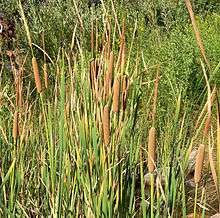Typha domingensis
Typha domingensis, known commonly as southern cattail[3] or cumbungi, is a perennial herbaceous plant of the genus Typha.
| Typha domingensis | |
|---|---|
 | |
| Scientific classification | |
| Kingdom: | Plantae |
| Clade: | Tracheophytes |
| Clade: | Angiosperms |
| Clade: | Monocots |
| Clade: | Commelinids |
| Order: | Poales |
| Family: | Typhaceae |
| Genus: | Typha |
| Species: | T. domingensis |
| Binomial name | |
| Typha domingensis | |
| Synonyms[2] | |
|
Typha angustata Bory & Chaub. | |
Distribution and habitat
It is found throughout temperate and tropical regions worldwide.[4] It is sometimes found as a subdominant associate in mangrove ecosystems such as the Petenes mangroves ecoregion of Yucatán.[5]
Uses
In the Mesopotamian Marshes of southern Iraq, Khirret is a dessert made from the pollen of this plant[6]. In Turkish folk medicine the female inflorescences of this plant and other Typha are used externally to treat wounds such as burns. Extracts of T. domingensis have been demonstrated to have wound healing properties in rat models.[7]
Water extracts of the fruit, female flower and male flower of Typha domingensis exhibit iron chelating activity as well as superoxide and nitric oxide scavenging activities. By contrast, only the fruit and female flower extracts were found to have alpha-glucosidase inhibitory activity.[8] A partially purified, proanthocyanidin-rich butanol fraction of the fruit was shown to be a competitive inhibitor of alpha-glucosidase, which also had concurrent antioxidant activity.[9]
Recently it was found that Typha domingensis is very effective at reducing bacterial contamination of water for agricultural use. This plant helps to reduce, up to 98 percent, pollution by enterobacteria (usually found in the intestines of mammals) involved in the development of disease.[10]
References
- Lansdown, R.V. (2019). "Typha domingensis". IUCN Red List of Threatened Species. 2019: e.T164208A120229199. Retrieved 11 August 2020.
- "Typha domingensis Pers.". World Checklist of Selected Plant Families (WCSP). Royal Botanic Gardens, Kew. Retrieved 5 January 2016 – via The Plant List.
- "Typha domingensis". Natural Resources Conservation Service PLANTS Database. USDA. Retrieved 12 December 2015.
- Kew World Checklist of Selected Plant Families, Typha domingensis
- World Wildlife Fund. Eds. M. McGinley, C. M. Hogan, & C. Cleveland. 2010. Petenes mangroves. Encyclopedia of Earth. National Council for Science and the Environment. Washington, DC.
- "Khirret".
- Akkol, E. K., et al. (2011). The potential role of female flowers inflorescence of Typha domingensis Pers. in wound management. Journal of Ethnopharmacology 133(3) 1027-32.
- Chai TT, Mohan M, Ong HC, Wong FC (2014) Antioxidant, iron-chelating and anti-glucosidase activities of Typha domingensis Pers. (Typhaceae). Tropical Journal of Pharmaceutical Research 13(1): 67-72.
- Chai TT, Chiam MJ, Lau CH, Mohd Ismail NI, Ong HC, Abd Manan F, Wong FC (2015) Alpha-glucosidase inhibitory and antioxidant activity of solvent extracts and fractions of Typha domingensis (Typhaceae) fruit. Tropical Journal of Pharmaceutical Research 14 (11): 1983-1990.
- Common weed revealed to diminish water pollution
